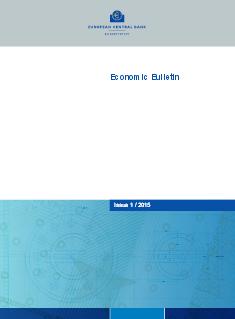ECB (2015) Update on Economic and Monetary Developments, Economic Bulletin Issue 1/2015, European Central Bank, February.
Summary
The recent decline in oil prices is supporting the global economic recovery. Nevertheless, the recovery remains gradual and economic developments vary across regions. Growth in the United States remains robust, momentum is slowing in China, and activity in Japan has not regained traction. Economic conditions in Russia have deteriorated further, but spillovers to other emerging markets remain limited to date. Global trade is showing signs of strengthening. The decline in energy prices has lowered inflation rates globally.
In euro area financial markets, short-term money market rates have declined further in an environment of increased excess liquidity, temporarily reaching new historic lows. Long-term interest rates also reached new historic lows, reflecting weak growth momentum and subdued inflation dynamics, as well as market expectations of sovereign debt purchases by the Eurosystem. At the same time euro area stock prices have increased. The exchange rate of the euro has depreciated further, both in nominal effective terms and against the US dollar.
Overall, the latest economic indicators and survey results remain consistent with a moderate economic expansion in the euro area in the short term, while the recent fall in oil prices should support growth in the longer term. Meanwhile, although labour markets have shown some further signs of improvement, unemployment remains high and unutilised capacity is expected to diminish only gradually.
Euro area HICP inflation declined significantly in December, to -0.2%. On the basis of current information, the short-term inflation outlook remains weak and annual HICP inflation is likely to stay very low or negative in the coming months. Supported by the ECB’s monetary policy measures, the ongoing recovery and the assumption embedded in futures markets of a gradual increase in oil prices in the period ahead, inflation rates are expected to increase gradually later in 2015 and in 2016.
The monetary analysis indicates that the annual growth of M3 recovered further in November. The decline in loans to non-financial corporations has continued to moderate, while the growth of loans to households has stabilised at a slightly positive level. These developments have been facilitated by a broad-based and substantial reduction in lending rates recorded since summer 2014. Despite the improvement in lending conditions, as reported in the January 2015 euro area bank lending survey, credit standards still remain relatively tight. The ECB’s monetary policy measures should support a further improvement in credit flows.
At its meeting on 22 January 2015, based on its regular economic and monetary analyses, the Governing Council of the ECB conducted a thorough reassessment of the outlook for price developments and of the monetary stimulus achieved so far. As a result, the Governing Council decided:
- first, to launch an expanded asset purchase programme, encompassing the existing purchase programmes for asset-backed securities and covered bonds as well as purchases of euro-denominated investment-grade securities issued by euro area governments and agencies and European institutions in the secondary market (for futher details, see Box 1);
- second, to change the pricing of the six remaining targeted longer-term refinancing operations (TLTROs) by removing the 10 basis point spread over the rate on the Eurosystem’s main refinancing operations that applied to the first two TLTROs;
- third, in line with its forward guidance, to keep the key ECB interest rates unchanged.




